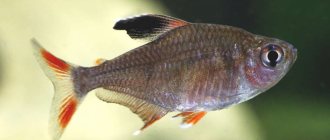On August 5, in the area of Nazimov Spit in Reid Pallada Bay near the village of Khasan, Primorsky Territory, local residents for the first time discovered a very rare marine semi-deep-sea fish - the king herring (Regalecus glesne), which is also called the belt fish, or belt fish. This fish is most often found in tropical waters, but can also be found in the Atlantic, as well as in warm, warm-temperate and temperate waters of the Pacific and Indian oceans. She had never been seen in Russia until August 2019. A local resident managed to catch a fish washed ashore Vladimir Tarasov. After taking a photo with the strapfish, the man released the unusual guest back into the sea, away from vacationers who feared that the fish might be poisonous.
Description
The belt fish belongs to the species of ray-finned fish, the family of the belt-bodied fish of the order Opaciformes. It was first scientifically described in 1772 by Norwegian zoologist Peter Ascanius. He studied specimens washed ashore by the sea near the city of Bergen. This is how people learned about the existence of strange fish.
Researchers call her the most beautiful sea creature.
This representative of the deep sea looks like this:
- The body is long and snake-like, instead of scales it is covered with bony tubercles, and there is no caudal fin.
- A short head with a small mouth and a vertical retractable mouth slit. Mostly all vital internal organs are concentrated in the head area. The jaw does not contain teeth, but has 40-50 plates for catching prey.
- The body has a light silver color with randomly scattered dark spots and stripes, and is covered with scales. The head is painted dark blue. The lateral fins are crimson.
- The swim bladder is missing.
- The main decoration of this unique fish is its fiery red mane, fluttering like a train. The mane is a dorsal fin consisting of individual red rays and resembles a crown. Because of this feature, the belt fish is often called the king.
It swims vertically and with its head up - and this is also its unique feature. It eats small crustaceans and plankton.
It lives in the Pacific, Atlantic and Indian oceans with a warm or temperate climate. Found off the coast of Iceland and the North Sea.
Yandex pictures
Miracles of adaptation
The long body of the fish, shaped like a ribbon, allows it to glide freely in the water without experiencing much resistance.
The rays of the fins near the head of the herring king rise upward, forming a bright red crest, which, in fact, has been transformed into a protective outfit to scare away predators.
The long dorsal fin, moving quickly, helps the fish dive vertically to depth. It is believed that the concentration of internal organs near the head allows the king to survive, even with the loss of a significant part of the elongated tail.
People tried to eat the belt, but it turned out that it was “not tasty”, and the meat was “flabby, sticky and resembles rubber”, so it is not a commercial fish.
Dimensions
The maximum length can reach 11 m, but individuals from 3 to 5 m are more common.
The body width does not exceed 7 cm and the height is 25 cm. The maximum weight reaches 272 kg.
Interesting fact: This is the longest bony fish, for this reason it is listed in the Guinness Book of Records.
Yandex pictures
Character and lifestyle
The fish moves in a very unusual way - vertically. The fish king's body weighs much more than water. To prevent it from sinking while swimming, it moves with forward wave-like movements using the dorsal fin. For this reason, the individual develops a low speed. If in some situation she needs to move faster, she bends both her fin and her entire body.
It is a predator, as it eats not only plankton and shellfish, but also squid and small fish. Often found in schools of herring, which also serves as food for it.
Breeds from July to December. The eggs are brightly colored and reach a size of 2 to 4 mm. They drift with sea or ocean currents and float on the surface of the water. This is where the larvae develop in winter.
The lifestyle is predominantly nocturnal. The duration of the life cycle has not yet been established.
The natural enemies of the fish king have also not been studied. But when some individuals washed ashore, it was discovered that some of them were left with marks of shark teeth and wounds from spearfish.
It feels great underwater at a depth of 500-1000 meters, but sometimes swims in surface waters.
Yandex pictures
Behavior, diet, interesting features
Due to their large size, many people mistakenly believe that beltworms are dangerous, but the opposite is true. In fact, they are shy and, due to their secretive nature, there is not enough data on the behavior of these huge sea creatures.
Herring kings do not swim, wriggling like eels, they “wander” in sea water in an upright position at a depth of 200 to 1000 meters, using their dorsal fins for this purpose. It is believed that beltworms prefer to live alone.
The first image of the strap was taken by a group of marine scientists in the Gulf of Mexico. These were the very first shots capturing him in his natural habitat.
The photo clearly shows that the fish is swimming with its tail down, in a vertical orientation. Strapfish use their dorsal fin to propel themselves underwater and maintain this body position even while feeding.
They feed on krill, plankton, small fish, squid, jellyfish and crustaceans, remaining completely motionless so as not to attract predators.
Human use
King fish is not used for commercial purposes. People do not eat its meat and consider it inedible. Also, some animals do not feed on it. Despite this, if the belt is caught in the fishermen's net, they take it to the fish market to sell. Some gourmets believe that fish can be cooked properly, and then it becomes a delicacy.
The marine predator has gained great popularity among amateur fishermen who show a sporting interest in catching it. Catching it is a great success and a manifestation of skill even for experienced fishermen.
Important: Fishing for recreational purposes threatens the complete destruction of individuals of this species. How many of them remain in nature is currently unknown.
Yandex pictures
First evidence
The first information about the herring king is found in the records of ancient times. They talk about a sea monster or a snake emerging from the depths of the sea. They called him the Great Sea Serpent. People were so amazed by the appearance of the unknown creature that they described it as a monster with the head of a bull or horse, with a fiery red mane. The sailors considered the meeting with the sea serpent not to promise anything good. The herring king became a legend, which was subsequently hunted by many natural scientists.
Why is it called that?
There are several names for fish, each based on the appearance or property of the predator.
The name “remnetel” or “belt fish” appeared due to the external similarity of the fish to the belt. It is the same long and flat body shape, and looks like a huge shiny belt. The length can reach 11 meters and the width is only 7 cm.
They began to call her the Herring King for two reasons:
- The predator received the title of king for its red ray fin on its back, reminiscent of a king's train or a crown.
- It was nicknamed the herring fish because sailors and fishermen often observed the presence of fish in a school of herring.
This is how the double name came about - “The Herring King”.
In Latin, “herring king” sounds like Regalecus glesne, where “rex” is a king and “allec” is a herring. The name was borrowed from Norwegian fishermen, who nicknamed this unusual creature for staying in schools of herring.
Interesting fact: In Japan, the remnetela was nicknamed the “king of the underwater palace.” Sometimes also called “paddle fish” due to the rotation of the body during movement.
Yandex pictures
Related species
Oarfish is a member of the family of ligaments, which also includes a very rare genus of agrosticths. Their description was compiled from only 7 specimens caught in the high seas of Australia, Tasmania, New Zealand and the south-eastern Atlantic Ocean.
The silvery body of agrostichts with a pink dorsal fin formed by 400 rays has no scales and is dotted with hard tubercles. The sensitive lateral line is represented by a continuous tube consisting of oblong plates. It is assumed that agrostiches do not grow more than 3 meters in length.
The order Oharfish is opaciformes. This means that its relatives include triggerfish and pearleyes, but the closest one is the serpentine fish. It is inferior to the king fish in terms of impressive size and spectacular appearance, prefers a secretive lifestyle, so it fell into the hands of scientists no more than five times.
However, her way of eating is well studied. Serpentine eats invertebrates and small fish. During the hunt, he extends his upper jaw so much that the area of his mouth increases 40 times. Unsuspecting victims fall into this trap.
Triggerfish are relatives of the belt fish
Link to earthquake and tsunami
The Japanese believe that the herring king is a harbinger of earthquakes and tsunamis. If it appears off the Japanese coast, then residents begin to prepare for these natural disasters. No scientific evidence has been provided for such assumptions.
Such theories are connected with the fact that earthquakes occur under water, as a result of which a tsunami is generated. And the king lives in the depths of the sea.
Yandex pictures
How could the herring king get to Russian shores?
A water whirlwind could have brought the herring king to the Russian shores. According to the head of the ichthyology laboratory of the Zoological Institute of the Russian Academy of Sciences, Arkady Balushkin, this fish is found in the northern part of the Pacific Ocean, although previously it was more often found near the coasts of California and Japan. “There are no obstacles for fish to be off our shores. Now it is becoming a little warmer, and more heat-loving species often penetrate into Primorye. There have even been cases of white sharks that have bitten people, although white sharks usually do not approach the shores of Primorye. The fact that a deep-sea fish was so close to the shore suggests that something could have happened to this specimen. This is a rare fish; it can be immediately taken to the museum if it has already died. Every capture of her is always discussed in the press,” says Balushkin about the belt.
Question answer
What new species of fish was discovered in Antarctica?
Myths and legends
Since the fish king is a unique and unusual-looking fish, many legends, speculations, and myths are associated with it:
There is a legend about a sea serpent. This is how the herring king was nicknamed in ancient times by scientists who mentioned him in their writings. One of them was the writer and philosopher Aristotle.
The people were afraid of meeting a snake, which, according to ancient beliefs, promised only misfortune and failure.
Often the remains of a huge fish could be found on the ocean shore. In the imagination of sailors, she was depicted as a giant monster with a bull or dragon neck and an orange mane. The red fins looked like algae, from whose bonds the monster was trying to get out.
Catholics perceived the belt as a miraculous fish that the Apostle Peter touched. They imagined the marks on the predator's body as marks from the Saint's fingers. According to them, Peter caught the sea creature while he was fishing and before he became a saint and followed Jesus Christ.
The Filipinos called the fish a harbinger of disaster and prepared for imminent cataclysms when meeting it.
Yandex pictures
Eyewitness accounts
Meetings with the herring king have taken place since ancient times. Ancient people saw it as a supernatural creature, and even in the modern world, when a scientific description of the organism has already been made, its appearance is still disconcerting. Rare eyewitness accounts are recorded whenever possible, some stories are simply interesting, others are almost detective stories.
In ancient times, the belt fish was considered a supernatural creature
Legend of the Sea Serpent
Before the creature was discovered and scientifically described, it was perceived by eyewitnesses as a sea serpent. It was seen in ancient times; the harpfish is mentioned in the works of classics, for example, Aristotle. People were afraid of encounters with huge fish; they promised misfortune. Her huge remains, which could be found on the shore, painted in the imagination of sailors a monster with a bull, dragon or, more often, horse head and an orange mane, for which the elongated rays of the dorsal fin could be mistaken. The red fins were mistaken for algae, in which the monster became entangled, emerging from the depths of the ocean to the surface.
But if most eyewitnesses perceived the fish only as a devilish creature, then Catholics believed that its spots on the skin were the fingerprints of the Apostle Peter, who was engaged in fishing before he followed Christ.
Many did not believe in the existence of such a beast, since there were few eyewitnesses, and all of them, being impressed, described what they saw in different ways. As incredible as it may sound, a sea serpent can actually exist. Only his role, most likely, was played not by the herring king, but by some giant eel.
Indirect confirmation of this was received in 1930, when a larva more than 120 cm long was caught off the coast of South Africa, which is more than 12 times the usual size of eels at this age. This finding means that there is a high probability that fish larger than 20 m in length exist. Perhaps these were the creatures that some sailors saw?
Another name for the belt fish is the sea serpent.
Latest evidence
They were afraid of this creature not only many centuries ago, but also in modern times. At the beginning of the 19th century, a nineteen-meter body was found, which was mistaken for a sea snake, although museum workers later claimed that it was a large specimen of a belt fish.
In the mid-20th century, in the Californian village of Malibu, a woman walking in the evening with her poodle saw a huge six-meter-long body on the ocean coast. She was so scared that her scream woke up all the neighbors, who immediately ran to the shore. One of them decided to hand over the body to the authorities and loaded it onto the roof of his car, but did not have time to drive away, as he was stopped by a police car.
The officers wanted to inspect the cargo on the roof. Seeing it in the headlights, they decided that the huge body could have value, which means it was dangerous to transport, so they decided to call experts. Their role was played by university zoologists Boyd Walker and Vlad Walter. They took the monster to the laboratory.
The herring king is one of the rare ocean fish
After carrying out all the necessary measurements and analyses, experts determined that the creature found was one of the rarest and most beautiful ocean fish, the king oar. The specimen found during this detective story was transferred to the Los Angeles Museum of Natural History, where it is still on display. Unlike other underwater inhabitants, the belt fish is surprisingly well preserved and looks almost life-like. The only defect is teeth marks on the tail, apparently the result of a fight with a shark.
Observations in the natural environment
In most cases, eyewitnesses met the herring king already dead, thrown onto land. But there are also those who were lucky enough to meet him in his native habitat - water. The recorded meetings were as follows:
- biologist Wood Jones saw the fish in 1906 near the island of Sumbawa, but attempts to catch it using nets were unsuccessful; the king did not respond to bait;
- naturalist K. Holder had the opportunity to observe the amazing creature in 1925 in the shallow waters of a bay in Southern California;
- the crew of a border helicopter flying past the Shantar Islands in 1972 observed from a 20-meter height a thin creature approximately 17 meters long frolicking on the surface, but after a few minutes disappeared into the depths;
- Fishermen setting nets in the eastern Pacific caught an oar king in 1986, but it died while trying to catch it.
Thus, the herring king is not a fairy-tale or mythical character, but a real living organism. This proves how amazing creatures nature produces, and suggests what other animals are hiding from human eyes in the underwater depths.











